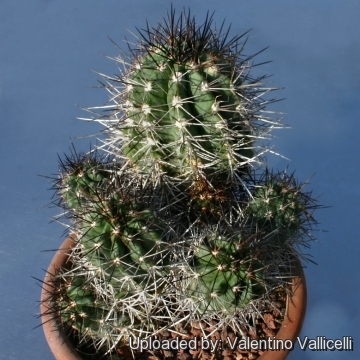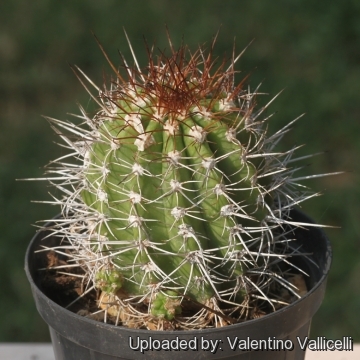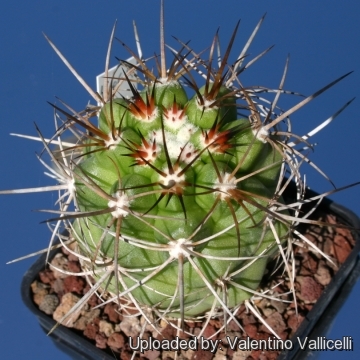= Copiapoa coquimbana var. pseudocoquimbana (F.Ritter) A.E.Hoffm.
Cact. Fl. Silvestre Chile 108 1989. A.E.Hoffm.
Accepted Scientific Name: Copiapoa coquimbana (Karw. ex Rümpler) Britton & Rose
Cactaceae (Britton & Rose) 3: 87, pl. 10. 1922 Britton & Rose Remarks: Ritter (Kakteen Sudamarika 3: 1074. 1980) also made this combination

Copiapoa coquimbana subs. pseudocoquimbana (Copiapoa coquimbana var. pseudocoquimbana) Photo by: Valentino Vallicelli
Origin and Habitat: The typical area goes from the mouth of the Rio Choros to La Serena but this plant occupies a far broader range, i.e. from Huasco until Fray Jorge National Park, Dept. La Serena, Province of Coquimbo, Nord-Chile.
Altitude: Below 300 metres
Habitat: It is found only in the coastal area and no more than 20 km inland.
Synonyms:
See all synonyms of Copiapoa coquimbana
back
Accepted name in llifle Database:Copiapoa coquimbana (Karw. ex Rümpler) Britton & RoseCactaceae (Britton & Rose) 3: 87, pl. 10. 1922Synonymy: 32
Accepted name in llifle Database:Copiapoa coquimbana subs. andina I.Schaub & KeimCactus & Co. 13(1): 13 (5-15; figs.). 2009 [Mar 2009]
back
Description: Copiapoa coquimbanaSN|1348]]SN|1348]] var. pseudocoquimbana (false Copiapoa coquimbanaSN|1348]]SN|1348]]) can be referred to a local form within the variability of Copiapoa coquimbanaSN|1348]]SN|1348]] characterized by longer and thinner spines, moreover radial spines are straight whereas they tend to curve toward the plant's body in the typical coquinbana. However there is a considerable variability in spine shape, size and colour and it is sometimes difficult to separate one local form from another and is also quite problematic to define a clearly distinction with other Copiapoa coquimbanaSN|1348]]SN|1348]] forms.
Habit: Caespitose, with a turnip-like root.
Stems: Depressed-globose 20-30 cm high, 5-10 cm Ø, green, covered with copious grey wool at the apex, particularly at flowering time. 10-15 cm in diameter that branches profusely, forming large clumps up 1 m large and 60 cm high.
Ribs: There are about 10-18 scant crenate.
Areoles: Apical, 5-8 mm diam, depressed or convex, covered with short wool when young, later glabrous about 0,5-0,8 cm, 2 cm apart.
Radial spines: 8-10 fairly slender, mostly straight and acicular, usually pale brown, but also honey-amber, red-brown or black becoming grey with age.
Central spines: 3-4 thicker 3-4,5 cm long (or more).
Roots: Roots-strong, long, thick, narrower at top.
Flowers: Campanulate about 4,5 cm long , bright sulfur yellow and grow from the centre of the white wool at the apex. Outer segments of the perianth are linear and greenishor reddish; inner segments are wide, blunt and yellow. Ovary pale green. Pericarpel scales red.
Fruits: Red brown.
Seeds: with large umbilicus.
Subspecies, varieties, forms and cultivars of plants belonging to the Copiapoa coquimbana group
 Copiapoa coquimbana (Karw. ex Rümpler) Britton & Rose: It branch profusely, forming large clumps up 1 m wide and 60 cm high. The spines are strong honey-amber, brown or black, and grey with age. Distribution: South of the Copiapoa genus range (from Coquimbo to La Serena)
Copiapoa coquimbana (Karw. ex Rümpler) Britton & Rose: It branch profusely, forming large clumps up 1 m wide and 60 cm high. The spines are strong honey-amber, brown or black, and grey with age. Distribution: South of the Copiapoa genus range (from Coquimbo to La Serena) Copiapoa coquimbana var. alticostata (F.Ritter) A.E.Hoffm.: has very strong, dark brown to black spines. Distributiom: between Freirina and Huasco.
Copiapoa coquimbana var. alticostata (F.Ritter) A.E.Hoffm.: has very strong, dark brown to black spines. Distributiom: between Freirina and Huasco. Copiapoa coquimbana subs. andina I.Schaub & Keim: has outstanding golden-yellow spines. This golden appearance is not typical of any other Copiapoa. Distribution: North east of Vallenar.
Copiapoa coquimbana subs. andina I.Schaub & Keim: has outstanding golden-yellow spines. This golden appearance is not typical of any other Copiapoa. Distribution: North east of Vallenar.- Copiapoa coquimbana var. armata F.Ritter
 Copiapoa coquimbana var. imbricata Kníže: has strong, chocolate-brown to almost black young spines. El Molle and adjacent areas, Rio Elavi.
Copiapoa coquimbana var. imbricata Kníže: has strong, chocolate-brown to almost black young spines. El Molle and adjacent areas, Rio Elavi. Copiapoa coquimbana var. pendulina (F.Ritter) A.E.Hoffm.: It is similar to C. pseudocoquimbana but with slightly stronger spines. Distribution: Coquimbo to Valparaiso.
Copiapoa coquimbana var. pendulina (F.Ritter) A.E.Hoffm.: It is similar to C. pseudocoquimbana but with slightly stronger spines. Distribution: Coquimbo to Valparaiso. Copiapoa coquimbana var. pseudocoquimbana (F.Ritter) A.E.Hoffm.: has longer and thinner spines, moreover radial spines are straight and not to curved toward the plant's body. Distribution: from the mouth of the Rio Choros to La Serena
Copiapoa coquimbana var. pseudocoquimbana (F.Ritter) A.E.Hoffm.: has longer and thinner spines, moreover radial spines are straight and not to curved toward the plant's body. Distribution: from the mouth of the Rio Choros to La Serena Copiapoa coquimbana vallenarensis (F.Ritter) A.E.Hoffm.: has few but steonger radial spines. Diatribution: Huasco and Vallenar Valley.
Copiapoa coquimbana vallenarensis (F.Ritter) A.E.Hoffm.: has few but steonger radial spines. Diatribution: Huasco and Vallenar Valley.- Copiapoa coquimbana var. wagenknechtii F.Ritter
 Copiapoa militaris Kníže: has stronger spines than the type. Distribution: Chanaralillo.
Copiapoa militaris Kníže: has stronger spines than the type. Distribution: Chanaralillo. Copiapoa pseudocoquimbana var. domeykoensis F.Ritter: is a giant form of C. coquimbana that is found on the far North part of the habitat of this species. Distribution: South-west of Domeyko.
Copiapoa pseudocoquimbana var. domeykoensis F.Ritter: is a giant form of C. coquimbana that is found on the far North part of the habitat of this species. Distribution: South-west of Domeyko. Copiapoa pseudocoquimbana f. variegata hort.: Variegated form. Garden origin (Nursery produced cultivar)
Copiapoa pseudocoquimbana f. variegata hort.: Variegated form. Garden origin (Nursery produced cultivar) Copiapoa pseudocoquimbana var. vulgata F.Ritter: has very long mostly stighter spines. Distribution: Coquimbo to Frai Jorge.
Copiapoa pseudocoquimbana var. vulgata F.Ritter: has very long mostly stighter spines. Distribution: Coquimbo to Frai Jorge. Copiapoa schulziana I.Schaub & Keim: mainly one-headed, non caespitose plants with much bigger head size, occasionally reaching heights of 50 cm as unbranched plants and up to 23 mm in diameter. Distribution: West of Domeyko, III region, Chile.
Copiapoa schulziana I.Schaub & Keim: mainly one-headed, non caespitose plants with much bigger head size, occasionally reaching heights of 50 cm as unbranched plants and up to 23 mm in diameter. Distribution: West of Domeyko, III region, Chile.
Notes: This taxon taxon has never been described as a species in its own right. Related to this plant, and perhaps not distinct from it, is Copiaoa fiedleriana, but it grows farther north, not along the coast but in an interior valley.
Bibliography: Major references and further lectures
1) Walther Haage “Kakteen von A bis Z” Anaconda ed. 2012 ISBN: 3866472609
2) Edward Anderson “The Cactus family” Timber Press, Incorporated, 2001
3) Friedrich Ritter - Kakteen in Südamerika (Ergebnisse meiner 20jährigen Feldforschungen) 1980
4) David R Hunt; Nigel P Taylor; Graham Charles; International Cactaceae Systematics Group. "The New Cactus Lexicon" dh books, 2006
 Copiapoa coquimbana subs. pseudocoquimbana (Copiapoa coquimbana var. pseudocoquimbana) Photo by: Valentino Vallicelli
Copiapoa coquimbana subs. pseudocoquimbana (Copiapoa coquimbana var. pseudocoquimbana) Photo by: Valentino Vallicelli Copiapoa coquimbana subs. pseudocoquimbana (Copiapoa coquimbana var. pseudocoquimbana) Photo by: Valentino Vallicelli
Copiapoa coquimbana subs. pseudocoquimbana (Copiapoa coquimbana var. pseudocoquimbana) Photo by: Valentino Vallicelli - KK86 (Collector: Karel Kníže) Locality: Trapiche, Chile. Altitude: 600m (Copiapoa coquimbana var. pseudocoquimbana) Photo by: Valentino Vallicelli
- KK86 (Collector: Karel Kníže) Locality: Trapiche, Chile. Altitude: 600m (Copiapoa coquimbana var. pseudocoquimbana) Photo by: Valentino Vallicelli Copiapoa coquimbana subs. pseudocoquimbana (Copiapoa coquimbana var. pseudocoquimbana) Photo by: Valentino Vallicelli
Copiapoa coquimbana subs. pseudocoquimbana (Copiapoa coquimbana var. pseudocoquimbana) Photo by: Valentino VallicelliCultivation and Propagation: Considering that Copiapoa coquimbanaSN|1348]]SN|1348]] var. pseudocoquimbana comes from a habitat with an extremely arid climate, they are remarkably tolerant of pot culture. These plants have taproots and are susceptible to overwatering. They requires also an appropriate air circulation. Copiapoas are summer grower species easy to cultivate.
Growth rate: This is a slow growing cactus kept for the beauty of its form that will make clumps given the best conditions.
Soils: It likes very coarse mineral cactus mix soil, but can become too elongated if compost is too rich.
Repotting: Use pot with good drainage.
Watering: It requires light but regular waterings in summer, but let the soil mix dry between waterings, but do not overwater (Rot prone), it must be strictly kept dry throughout the winter quiescent period since it is very sensitive to any moisture excesses keep dry in winter.
Fertilization: Feed with a high potassium fertilizer in summer.
Hardiness: Not highly tolerant of a great deal of frost. They need to be kept in a cool place during winter rest and are resistant to light frost if kept on the dry side prior to, and during, cold weather ( they are hardy to -2 C ° C short periods). However some warmth throughout the year will increase the grower's success (minimum 5° to 10°C during rest season).
Exposition: Requires full sun or light shade and careful watering to keep plant compact with strong coloured spines. Tends to bronze in strong light, which encourages flowering and heavy spine production. Light shadow my be useful in the hottest summer days.
Uses: It is an excellent plant for container growing. It always looks good and stays small. It look fine in a cold greenhouse and frame or outdoor in a rockery.
Pests & diseases: It may be attractive to a variety of insects, but plants in good condition should be nearly pest-free, particularly if they are grown in a mineral potting-mix, with good exposure and ventilation. Nonetheless, there are several pests to watch for:
- Red spiders: Red spiders may be effectively rubbed up by watering the infested plants from above.
- Mealy bugs: Mealy bugs occasionally develop aerial into the new growth among the wool with disfiguring results, but the worst types develop underground on the roots and are invisible except by their effects.
- Scales: Scales are rarely a problem. It is wise to treat your whole collection with a systemic insecticide twice a year in spring and autumn.
- Rot: Rot is only a minor problem with cacti if the plants are watered and “aired” correctly. If they are not, fungicides won't help all that much. To prevent rottenness it is also advisable to surround its root neck by very rough sand or grit, this help a fast water drainage.
Propagation: Seeds (or offsets if available), Grafting is often used to speed growth rate and to create a back-up to plants in collection. Seeds germinate in 7-14 days at 21-27° C in spring, remove gradually the glass cover as soon the plants will be well rooted (ca 1-2 weeks) and keep ventilated, no full sun for young plants!















